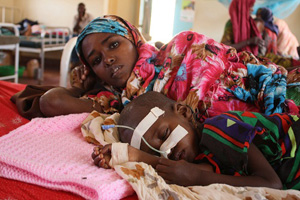
At a refugee camp in northeast Kenya, a mother and child lie in the malnutrition ward of a hospital. When children are too weak from hunger to eat, they are fed intravenously. Photo by Laura Sheahen/CRS
Credits: Laura Sheahen/CRS
By Laura Sheahen
“I met a woman who was crying because she couldn’t remember the last time she had seen so much food.” Shadrack Musyoka of Caritas is recalling a summer 2011 food distribution in a drought-stricken region of southern Kenya. “She hadn’t eaten for two or three days. She was too weak to stand.”
“She realized she was going to eat her fill.”
Hundreds of kilometres north, “the drought was so horrible, some children would collapse from hunger,” says Father Isaac Racho of the diocese of Marsabit. Three years of poor rains had culminated in a catastrophe worse than many adults could remember. The drought hit huge swaths of Kenya, Somalia, Ethiopia, Eritrea—most of the countries that make up the Horn of Africa. Everything was brown dust.
“When droughts get bad, people here eat leaves,” says Maurice Savei of Caritas Kitui. This time, in some areas, that wasn’t an option. “Usually when there’s no rain, there’s still a tree with a kind of small coconut that they eat. In this drought, even that tree failed.”
Herdsmen would go farther and farther to find green pasture for their cattle and goats, leaving behind family members who could not travel. “They went far for water, 80 kilometres, with their flocks,” says Gabriel Gambare of Kenya’s diocese of Marsabit. Meanwhile, there was no food at home. “They’d come back and their elderly parent would be almost dead.”
“Many times I am called when someone is sick. When I get there, it turns out it’s because the person is hungry—they haven’t had food for two or three days,” says Father Racho.
“People would come here to the parish house even before I woke up, saying ‘My children didn’t eat last night,’” he goes on. “You could see on their faces the agony and the anger.”
Villagers watched the animals around them grow thin and die. “You’d see heaps of dead goats, elephants,” says Emmanuel, a labourer who lives in Marsabit. “The monkeys would come into houses to steal food. They would grab the cooking pots.”
Whenever there’s a way to farm, Caritas helps people help themselves. Irrigation projects Caritas developed in the 1990s and early 2000s saved many people during the 2011 drought. But with no rain, many herdsmen and farmers simply couldn’t produce food. So Caritas started trucking in drinking water and food, driving lorries over near-impassable dirt roads in villages the government can’t always reach.
Zeinabu Eisimfecha, a widow raising her seven children in Marsabit, is unequivocal about the results of the emergency rations. “If not for Caritas, we would have died,” she says flatly. “It would have been the end of the world.”
At a Caritas food distribution at Father Racho’s parish, over 100 women wait as sacks of beans, rice and a corn-soy mix are hauled out of the storeroom. There’s only one knife to slit open the many sacks, so rather than lose time, the women painstakingly untie the sacks’ complicated sewed binding with their fingers. Then they hold out their own empty bags to receive scoops of the food.
The fabric of one bag is worn in one patch; a few grains of rice slide out from the bottom every time a staffer scoops rice into a woman’s sack. Another woman guards the worn patch, guiding the spilled grains onto a piece of cloth so that no rice is wasted.
The women strap the food sacks onto their backs and prepare to walk several kilometres home. Often they’re carrying their babies as well.
Newborns and their mothers were especially at risk during the drought. At rural clinics, medical staff give out Caritas food to help save underweight babies. The food goes to the mothers as well. “It’s been difficult to breastfeed twins,” says Susan Wanjiru, whose baby boys are six months old. “I’ve never had enough to eat, the whole time. Sometimes I am so hungry and the milk doesn’t come.”
“In the past, we were losing children under five to malnutrition,” says Mwinzi Munyoki Tutu, a young father in southern Kenya. “This time, we didn’t.”
Not every child made it, says Bishop Peter Kihara in the north. “The most painful thing is that the disabled children are hidden, sometimes even tied to a bed” because of a combination of cultural factors and shame. “When hunger strikes, they suffer even more. Disabled children died, tied to the bed.”
But Caritas did manage to reach, and feed, hundreds of thousands of vulnerable people during the drought. In many parts of East Africa, rains began in October 2011. Villagers pray that the worst of their suffering is over. To help them start again, Caritas is distributing seeds, animals, and other things they need. Caritas also pays villagers to work on irrigation projects that will lessen the impact of any future droughts. The emergency rations make that work easier. One woman digging a canal says, “the energy you see us digging with, that’s from the Caritas food.”
“God comes in so many ways,” says Kyambi Ngui, an elderly woman living in a village called Musavani. “We were waiting for death, but then Caritas came. I don’t know how we would have survived without Caritas. We’re so grateful you heard our cries and came to our rescue.”
